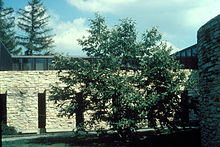Castanea mollissima
| Chinese chestnut | |
|---|---|
 |
|
| Scientific classification | |
| Kingdom: | Plantae |
| (unranked): | Angiosperms |
| (unranked): | Eudicots |
| (unranked): | Rosids |
| Order: | Fagales |
| Family: | Fagaceae |
| Genus: | Castanea |
| Species: | C. mollissima |
| Binomial name | |
|
Castanea mollissima Blume |
|
| Nutritional value per 100 g (3.5 oz) | |
|---|---|
| Energy | 1,000 kJ (240 kcal) |
|
52.36 g
|
|
|
1.19 g
|
|
| Saturated | 0.175 g |
| Monounsaturated | 0.620 g |
| Polyunsaturated | 0.307 g |
|
4.48 g
|
|
| Tryptophan | 0.052 g |
| Threonine | 0.178 g |
| Isoleucine | 0.167 g |
| Leucine | 0.276 g |
| Lysine | 0.243 g |
| Methionine | 0.108 g |
| Cystine | 0.117 g |
| Phenylalanine | 0.203 g |
| Tyrosine | 0.134 g |
| Valine | 0.235 g |
| Arginine | 0.459 g |
| Histidine | 0.129 g |
| Alanine | 0.213 g |
| Aspartic acid | 0.909 g |
| Glutamic acid | 0.573 g |
| Glycine | 0.196 g |
| Proline | 0.172 g |
| Serine | 0.196 g |
| Vitamins | |
| Vitamin A equiv. |
(0%)
0 μg |
| Thiamine (B1) |
(13%)
0.150 mg |
| Riboflavin (B2) |
(8%)
0.090 mg |
| Niacin (B3) |
(10%)
1.500 mg |
| Pantothenic acid (B5) |
(12%)
0.592 mg |
| Vitamin B6 |
(34%)
0.437 mg |
| Folate (B9) |
(18%)
72 μg |
| Vitamin B12 |
(0%)
0.00 μg |
| Vitamin C |
(46%)
38.4 mg |
| Minerals | |
| Calcium |
(2%)
19 mg |
| Iron |
(12%)
1.50 mg |
| Magnesium |
(25%)
90 mg |
| Manganese |
(81%)
1.708 mg |
| Phosphorus |
(15%)
102 mg |
| Potassium |
(10%)
477 mg |
| Sodium |
(0%)
4 mg |
| Zinc |
(10%)
0.93 mg |
| Other constituents | |
| Water | 40.20 g |
|
|
|
|
|
| Percentages are roughly approximated using US recommendations for adults. Source: USDA Nutrient Database |
|
Castanea mollissima (Chinese chestnut) is a member of the family Fagaceae, and a species of chestnut native to China, Taiwan, and Korea.
It is a deciduous tree growing to 20 m tall with a broad crown. The leaves are alternate, simple, 10–22 cm long and 4.5–8 cm broad, with a toothed margin. The flowers are produced in catkins 4–20 cm long, with the female flowers at the base of the catkin and males on the rest. The fruit is a densely spiny cupule 4–8 cm diameter, containing two or three glossy brown nuts; these are 2–3 cm diameter on wild trees. The scientific name mollissima derives from the softly downy shoots and young leaves.
Synonyms: Castanea bungeana Blume; C. duclouxii Dode; C. fargesii Dode; C. formosana (Hayata) Hayata; C. hupehensis Dode; C. mollissima var. pendula X. Y. Zhou & Z. D. Zhou; C. sativa Miller var. formosana Hayata; C. sativa var. mollissima (Blume) Pampanini; C. vulgaris Lamarck var. yunnanensis Franchet.
In Vietnam, Chinese chestnut (Vietnamese language: hạt dẻ, Tày language: mác lịch) which are grown in Trùng Khánh district, Cao Bằng province have highest quality with 3.3-5.4% glucose, 43.36- 46.47% glucid, 1.16 – 2% lipid, 3.12 – 3.62% protein analyzed by Vietnam National Vegetable and Fruit Researching Institution in 1999.
Naturally an understory tree, Chinese chestnut has been cultivated in East Asia for millennia and its exact original range cannot be determined. In the provinces of Anhui, Fujian, Gansu, Guangdong, Guangxi, Guizhou, Hebei, Henan, Hubei, Hunan, Jiangsu, Jiangxi, Liaoning, Nei Mongol, Qinghai, Shaanxi, Shandong, Shanxi, Sichuan, Xizang, Yunnan, and Zhejiang, and also to Taiwan and Korea. It grows close to sea level in the north of its range, and at altitudes of up to 2,800 m in the south of the range. The species prefers full sun and acidic, loamy soil, and has a medium growth rate.
...
Wikipedia
